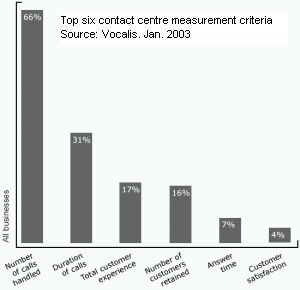 UK businesses are not taking advantages of the opportunities presented by contact centres to support their brands and build customer loyalty. Rather, they are fire-fighting perennial and predictable problems such as large call volumes, fluctuations, peaks and a range of staff issues. These are the conclusions of a Vocalis report published earlier in January. Commissioned to Resource Research, a B2B consultant, the study involved around 500 telephonic inquiries to decision makers in UK call centres with more than 50 seats.
UK businesses are not taking advantages of the opportunities presented by contact centres to support their brands and build customer loyalty. Rather, they are fire-fighting perennial and predictable problems such as large call volumes, fluctuations, peaks and a range of staff issues. These are the conclusions of a Vocalis report published earlier in January. Commissioned to Resource Research, a B2B consultant, the study involved around 500 telephonic inquiries to decision makers in UK call centres with more than 50 seats.
According to Vocalis, businesses follow the common mistake of impairing call centres potential on building a good CRM by prioritising measurement criteria over other aspects:
Businesses in fact measure the success of their centre on functional criteria, ones not always compatible with providing service. Performance measures prioritised by businesses are about getting calls handled quickly, the report notes. Two-thirds of businesses said that the performance of their call centres was based on the number of calls handled, while not even a third assessed it on measurement of call duration.
As stated on the study, only four per cent said they measured their call centres on customer satisfaction or retention, and as much as three business sectors made a significant reference to this criterion.
Dealing with call volumes is another aspect that, according to Vocalis, is being mishandled by businesses. Four in five businesses reported that call fluctuations were a significant problem for them. Call peaks can arise at different times of the day: some 50 per cent of the businesses spotted the morning time, 25 per cent the afternoons and 19 per cent Mondays.
The quick fix way to deal with call fluctuations is to employ more staff. However, contact centre managers often cannot afford enough staff to cover peak times. Even if they can, it is impossible to organise shifts so they cover peaks efficiently because fluctuations occur for short periods of time.
This often means that contact centres are over-staffed at times when call volumes are low. Yet, because businesses are trying to keep costs down, they are still under-staffed at peak call times, the study adds.
Despite the 25 per cent turnover in UK call centres, some 52 per cent of the respondents in this study pointed low morale amongst call agents a major concern and 20 per cent said boredom created difficulties.
High staff turnover and poor retention means that contact centre managers are constantly spending time and money re-training new recruits. It becomes difficult to build a loyal and dedicated workforce of call agents representing a businesses and brand correctly, the study concludes.
Vocalis states yet that nearly a third (27 per cent) of businesses do not currently have a written strategy for the next 12 months, while 45 per cent do not have one for the next three years. The risk is that customers are led to expect one thing through the marketing and positioning of the business, but they do not receive it when they make contact with business.
Contact centres are a major industry in UK, employing around 2 per cent of the labour force and contributing with around 8.32 billion euros to the British economy.
Em Foco – Pessoa

